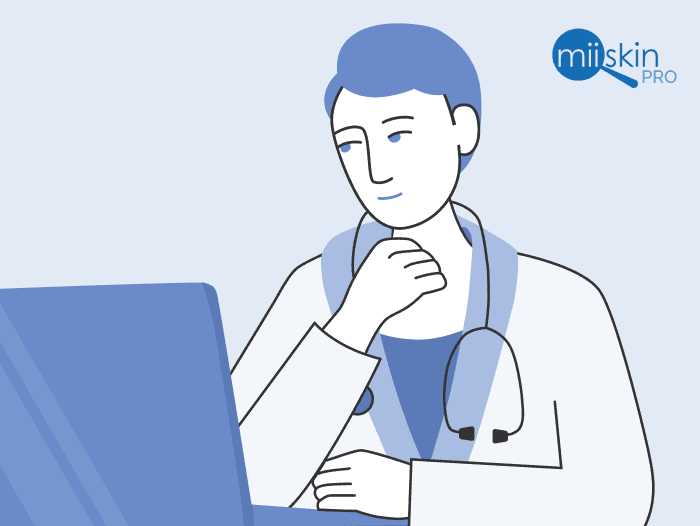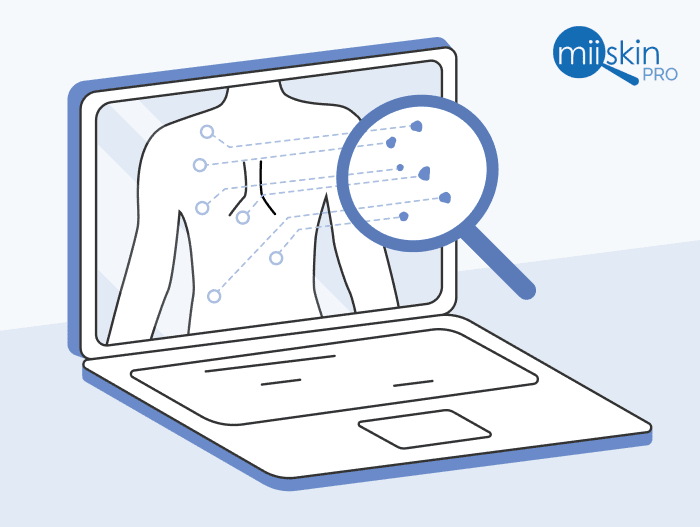Teledermatology Apps: Revolutionizing dermatology care
Discover how these 7 teledermatology apps for providers and patients are transforming dermatology care.
Table of content:
Benefits | Use-cases | Miiskin | FirstDerm | iDoc24 | RealSelf | DermEngine | VSee Health | DermatologistOnCall | Miiskin for private dermatology practices | Is it worth developing your own teledermatology app?
Teledermatology apps are transforming the way dermatological care is delivered by enabling remote consultations, monitoring, and diagnosis using digital tools. These mobile solutions make it easier for patients to receive expert skin care while helping providers manage more cases with greater efficiency.
A common and highly effective model is the store-and-forward teledermatology app, where patients send images and history for review at a later time. This approach reduces wait times and increases the number of cases dermatologists can assess in a given day.
However, with several teledermatology apps available on the market, selecting the right one can be challenging. Below, we explore how some of the best teledermatology apps are used and what to consider when choosing one.
Benefits of Teledermatology apps for providers and patients
Teledermatology apps are a valuable tool for both healthcare providers and patients. Dermatologists can streamline their workflow and offer virtual consultations, while patients gain faster access to skin assessments and follow-ups without visiting a clinic.
Key benefits include:
- Reduced patient wait times
- Increased provider efficiency
- Secure photo sharing for diagnosis
- Improved accessibility in rural or underserved areas
FOR DERMATOLOGISTS IN USA
Want a steady stream of new patients every month?
Partner with Miiskin and start receiving a steady stream of new patients — simply by joining the platform!
✅ You must have a private practice
✅ You must have your own malpractice insurance (we can help you set-up one)
There’s no upfront subscription — just a $10 usage fee.
Boost your revenue starting today!
Teledermatology app use cases: From virtual visits to remote monitoring
Modern teledermatology apps support a wide range of clinical tasks:
- Virtual consultations: Patients can request assessments for new or existing symptoms.
- Prescription renewals: Dermatologists can renew patient prescriptions based on image review.
- Follow-ups: Providers can monitor progress after an initial diagnosis using remote patient monitoring.
- Self-monitoring: Patients document changes in skin conditions with photos, which can be reviewed during future visits.
List of Teledermatology apps
Miiskin
Telehealth app specifically designed for dermatology.
- Suitable for: dermatology chains and independent dermatology practices.
- Dermatologist status: Self-employed dermatologists with a private practice.
- Platform subscription: $10 usage fee per consultation (no upfront subscription payment)
- Marketing support: Yes – patient acquisition handled entirely by platform. A patient widget can be added to the clinic’s website; full marketing support available.
- Async/Synch: Primarily asynchronous; video available as needed.
- HIPAA‑compliant: Yes.
- GDPR‑compliant: Yes.
- E‑prescription: Prescribe through integrated e‑prescribing tools.
- Integrated payment system: Yes.
FOR DERMATOLOGISTS IN USA
Want a steady stream of new patients every month?
Partner with Miiskin and start receiving a steady stream of new patients — simply by joining the platform!
✅ You must have a private practice
✅ You must have your own malpractice insurance (we can help you set-up one)
There’s no upfront subscription — just a $10 usage fee.
Boost your revenue starting today!
FirstDerm
Telehealth platform specifically designed for dermatology.
- Suitable for: independent dermatology clinics and dermatology chains.
- Dermatologist status: Self-employed dermatologists with private practices.
- Platform subscription: N/A
- Marketing support: Likely limited—platform generates its own traffic through the consumer-facing app.
- Async/Synch: Asynchronous only.
- HIPAA‑compliant: Not applicable due to the anonymous consults.
- GDPR‑compliant: Yes.
- E‑prescription: No.
- Integrated payment system: Yes.
iDoc24
Telehealth platform specifically designed for dermatology.
- Suitable for: independent dermatologists via professional portal.
- Dermatologist status: Self-employed dermatologists with private practices.
- Platform subscription: N/A
- Marketing support: Limited—referral-driven rather than full marketing.
- Async/Synch: Asynchronous only.
HIPAA‑compliant: Not applicable due to the anonymous consults. - GDPR‑compliant: Yes.
- E‑prescription: No.
- Integrated payment system: Yes.
RealSelf
Telehealth platform specifically designed for cosmetic dermatology.
- Suitable for: aesthetic dermatology clinics; not a full telemedical system.
- Dermatologist status: Self-employed cosmetic practitioners.
- Platform subscription: N/A
- Marketing support: Yes – lead generation and platform-driven traffic; providers pay per lead or consultation outcome.
- Async/Synch: Asynchronous Q&A; no live video consults.
- HIPAA‑compliant: Not applicable
- GDPR‑compliant: Unknown
- E‑prescription: No.
- Integrated payment system: No.
DermEngine
Telehealth platform specifically designed for dermatology.
- Suitable for: dermatology chains and health systems.
- Dermatologist status: For self-employed dermatologists in hospitals or health systems.
- Platform subscription: Offers licensing to enterprises tailored to organizations.
- Marketing support: Offers referral network tools.
- Async/Synch: Supports both asynchronous (store‑and‑forward) and synchronous (live video).
- HIPAA‑compliant: Yes
- GDPR‑compliant: Yes
- E‑prescription: Yes, via EHR integration.
- Integrated payment system: No.
VSee Health
Generic telehealth platform for hospitals that can also be used for dermatology.
- Suitable for: hospitals and health systems.
- Dermatologist status: self-employed dermatologists in hospitals or health systems.
- Platform subscription: Optional – free basic version available; premium plans charged per provider or custom configuration.
- Marketing support: No, dermatologists are responsible for their own patient acquisition and promotion.
- Async/Synch: Both asynchronous and synchronous (live video) supported.
- HIPAA‑compliant: Yes.
- GDPR‑compliant: No.
- E‑prescription: Yes, via optional EPCS integration.
- Integrated payment system: Yes.
FOR DERMATOLOGISTS IN USA
Want a steady stream of new patients every month?
Partner with Miiskin and start receiving a steady stream of new patients — simply by joining the platform!
✅ You must have a private practice
✅ You must have your own malpractice insurance (we can help you set-up one)
There’s no upfront subscription — just a $10 usage fee.
Boost your revenue starting today!
DermatologistOnCall
Telehealth platform specifically designed for dermatology.
- Suitable for: independent dermatologists and private clinics.
- Dermatologist status: Self-employed dermatologists with private practices.
- Platform subscription: N/a
- Marketing support: Yes – platform sources patients for providers.
- Async/Synch: Asynchronous only.
- HIPAA‑compliant: Yes.
- GDPR‑compliant: Unknown.
- E‑prescription: Yes.
- Integrated payment system: Yes.
Why Miiskin PRO is the best choice for private practice dermatologists
As the teledermatology landscape expands, dermatologists in private practice need a platform that balances clinical freedom, operational simplicity, and financial efficiency. Among all the available options, Miiskin PRO stands out as the most practical and provider-friendly solution.
Here’s why:
- No subscription fees – Unlike other platforms with complex licensing or recurring costs, Miiskin PRO uses a transparent pay-per-case model. You only pay $10 per consultation, keeping overhead low and profits high.
- Built for independent dermatologists – Miiskin PRO is designed to support self-employed providers without locking them into networks or employer arrangements. You control your caseload, pricing, and schedule.
- Asynchronous convenience – With its store-and-forward model, you review cases when it suits you—no need to coordinate live video calls or rearrange your day.
- HIPAA and GDPR compliant – Miiskin PRO ensures full compliance, making it ideal for both U.S. and international practices prioritizing patient data security.
- Integrated e-prescribing and payments – Handle clinical, legal, and financial tasks within one secure platform. No third-party systems required.
- Marketing support that brings patients to you – From a customizable website widget to platform-driven patient traffic, Miiskin PRO helps you attract and retain patients—without needing a marketing degree.
Is it worth developing your own Teledermatology app?
Probably not—especially when a proven, customizable solution like Miiskin PRO already exists.
Building a teledermatology app from scratch is expensive, time-consuming, and resource-intensive. You’ll need to consider regulatory compliance (HIPAA, GDPR), data security, technical infrastructure, UI/UX design, e-prescribing integration, payment systems, and ongoing maintenance. And even if you succeed, attracting and retaining patients requires a full marketing strategy and significant investment.
Instead of reinventing the wheel, Miiskin PRO offers a co-branded or white-label solution that is readily available. More importantly, Miiskin PRO was developed in close collaboration with dermatologists who run successful virtual practices. That means everything from the platform’s layout to its clinical workflows and compliance features were designed with American private practices in mind.
Why choose Miiskin PRO instead of building your own app?
- Faster to market – Launch your branded teledermatology service in days, not months.
- Cost-effective – No need to hire developers or manage ongoing updates and security.
- Clinically validated – Built with input from dermatologists who understand real-world workflows.
- Compliant out of the box – Fully HIPAA and GDPR compliant, with integrated e-prescribing and secure payment systems.
- Customizable branding – Co-brand the app and patient portal with your clinic’s identity.
Bottom line: Developing your own app can distract you from what you do best—treating patients. With Miiskin PRO, you get a ready-to-use, dermatologist-designed solution that looks like your own but works out of the box.
If you’re ready to modernize your practice, minimize administrative burden, and reach more patients with less hassle, Miiskin PRO is the teledermatology platform built for you.
Read more about three dermatologists who have built successful private practices with Miiskin.
FOR DERMATOLOGISTS IN USA
Want a steady stream of new patients every month?
Partner with Miiskin and start receiving a steady stream of new patients — simply by joining the platform!
✅ You must have a private practice
✅ You must have your own malpractice insurance (we can help you set-up one)
There’s no upfront subscription — just a $10 usage fee.
Boost your revenue starting today!
Are you a dermatologist who wants to learn more about teledermatology?
Check out our articles on Teledermatology
Teledermatology: Bridging the gap in dermatological care
Miiskin the future of teledermatology: What four dermatologists learned firsthand
How store and forward telehealth supports direct-to-consumer healthcare
7 Teledermatology apps doctors should know about
5 Teledermatology companies to choose from based on your needs
Choosing the right teledermatology software
References:
1https://dermnetnz.org/topics/teledermatology
2https://server.aad.org/forms/policies/Uploads/PS/PS-Teledermatology.pdf
3https://jamanetwork.com/journals/jamadermatology/fullarticle/2778026
4https://patientengagementhit.com/news/long-wait-times-in-dermatology-harm-patient-experience-safety
5https://onlinelibrary.wiley.com/doi/10.1111/pde.14479
6https://patientengagementhit.com/news/long-wait-times-in-dermatology-harm-patient-experience-safety
7https://patientengagementhit.com/news/long-wait-times-in-dermatology-harm-patient-experience-safety




 Join the Miiskin network and get new patients every month!
Join the Miiskin network and get new patients every month!